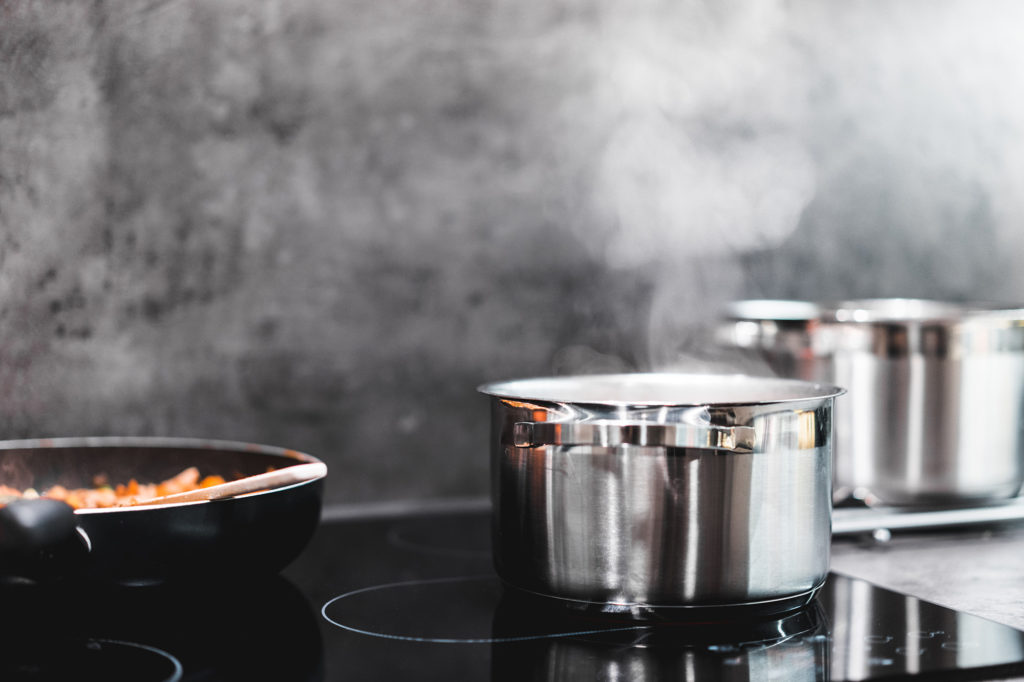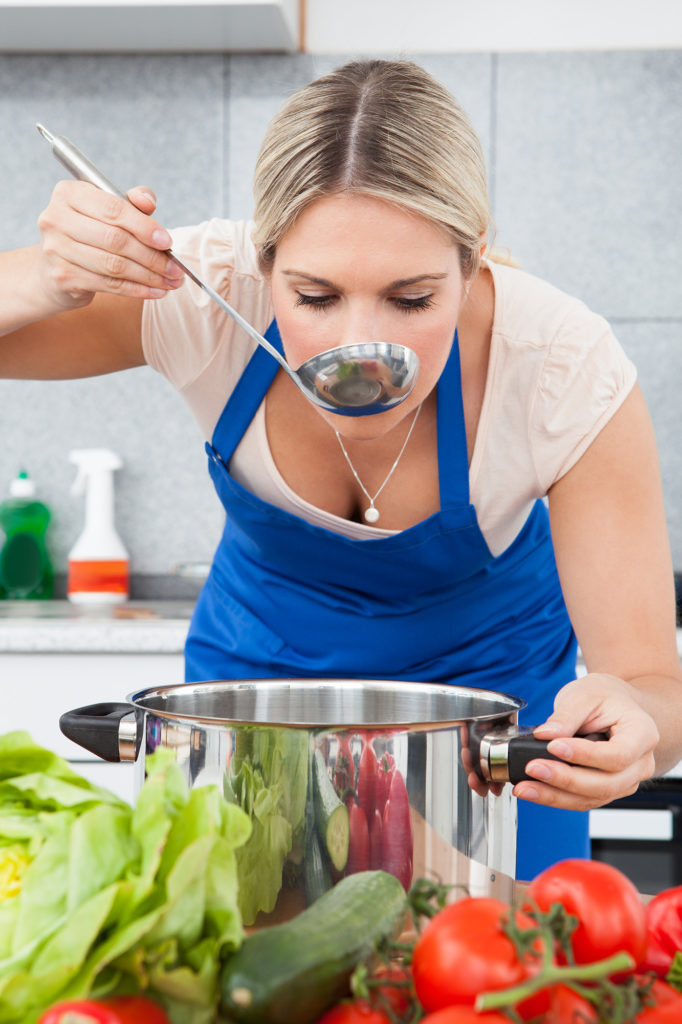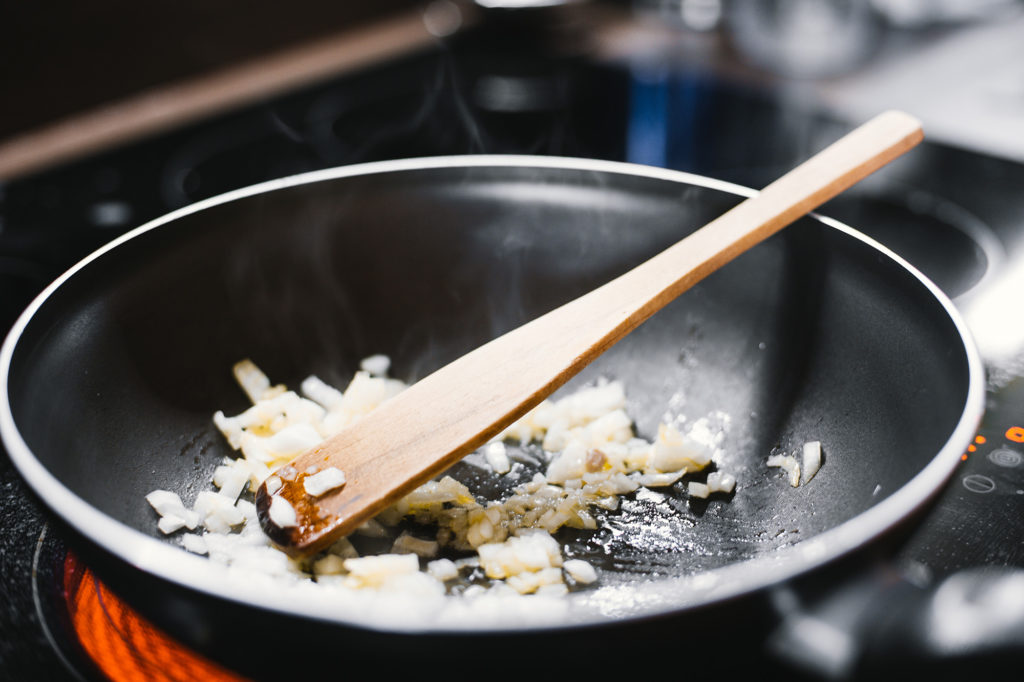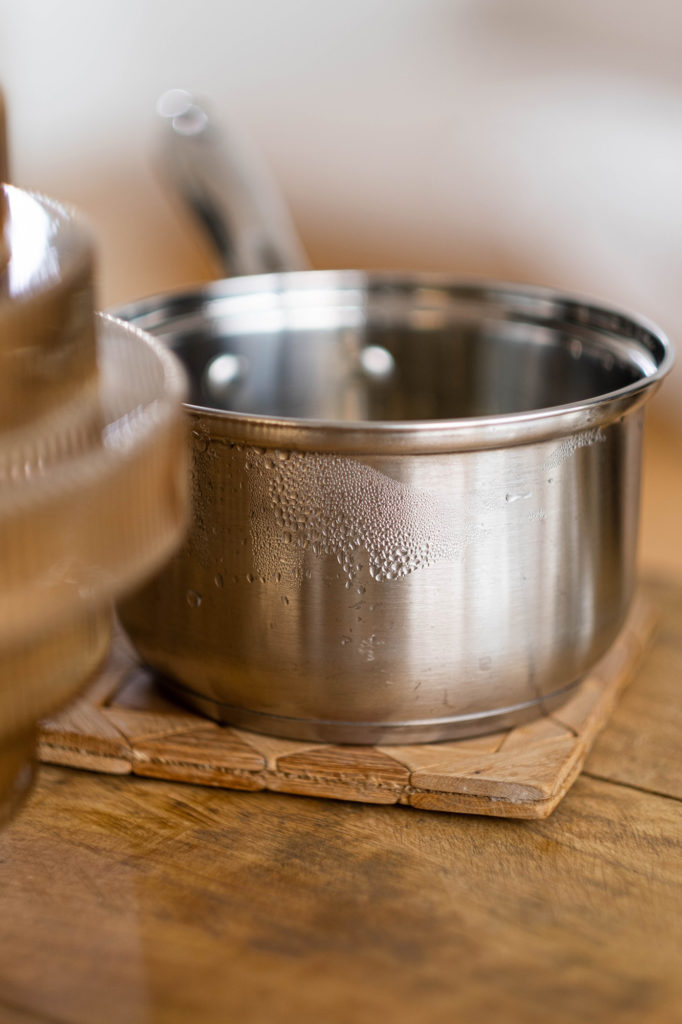There is no end to choices one has to make when searching for a new cookware piece. While size, shape, color can seem like easy decisions to make, what cookware material reigns supreme seems to be an eternal topic of debate.

Ceramic and stainless steel are two very popular options to consider if you are avoiding pans coated with Teflon / PTFE. Both materials are safer for you and the environment, but which is better, ceramic or stainless steel cookware?
What is Ceramic Cookware?
Ceramic cookware is basically any kiln-fired clay; pots, baking dishes and trays. But right now, we’re mostly talking about ceramic coated cookware; metal cored pots, pans and skillets that are coated in a ceramic, slick coating. The coating is made of fine sand and some man-made chemicals. Do those chemicals make the cookware unsafe? Nobody is quite sure. The jury is still out. It’s just too new of a product at this point.

Most ceramic coated cookware is coated in multiple layers of silica, which is everywhere on earth, mostly beaches, as it’s basically sand. The sand is made into a gel and sprayed over a metal base and then is cooked on at a high temperature. The coating not only makes the item “non-stick,” but it also opens up the opportunity for different colored cookware, which is a boon to kitchen designers out there.
But one thing is certain, the non-stick surface will wear out in time just like Teflon and PTFE. Even if you’re really good and only use wooden, plastic, or silicon utensils, the non-stick surface will become a stickier surface. In all likelihood you’ll replace your ceramic cookware more often than stainless steel.
For the uninitiated, ceramic cookware is easier to cook delicate foods, like dumplings, than on stainless steel cookware, where items are more likely to stick to the cooking surface. If you commonly find yourself scraping stuck food or soaking your pans, then ceramic cookware is definitely worth a look.
What is Stainless Steel Cookware?
Stainless steel cookware is one of the most classic cookware materials on the market. It’s a mixture of multiple types of metals; mainly iron and chromium, neither of which are toxic. On the rare occasion, you’ll see iron and chromium mixed with nickel.
Usually, stainless steel is free of coatings which makes it super easy to tag as a “safe” material for your kitchen. Just like any other cookware, if you heat it up too much for too long it might release some chemicals into your food, but nothing near like how overheated PTFE can kill birds! Again, that’s the the main worry when it comes to toxicity in all cookware.
A nice thing about stainless steel cookware is, because it isn’t coated with anything, it lasts much longer than ceramic cookware. Stainless steel cookware can handle high heat better. And treat a high quality set well and they will outlive probably you. Coatings on non-stick cookware and ceramic-coated cookware tend to wear over time from washing and cooking over high temps.
To the naked eye, stainless steel cookware is just that, stainless steel. But, if you were to cut a stainless steel pan in half, on the inside you’d see layers of materials on the bottom of the pan. The material is usually made up of aluminum or copper. Sometimes you’ll find pots and pans made up of multiple layers, sometimes you’ll find just one sheet sandwiched between stainless steel. Adding these extra layers of material make it so your pots and pans conduct heat better and more evenly.

Is ceramic or steel better for cooking?
As usual, comes down to your preferences. The bottom line is most people will really love the ceramic non-stick. It’s vastly easier to use and clean than stainless steel. Plus it’s widely considered healthier than PTFE coated or Teflon cookware.
Stainless steel cookware will last a lot longer, maybe a lifetime, and endure much rougher treatment than ceramic non-stick. Quality stainless steel is known to be safe and non-reactive for humans, that’s why it’s used in dentists tools and surgical instruments. And you can use steel wool to scrape off anything that gets stuck to the pan, but that’s the problem – stuff tends to stick to stainless steel. This is glaringly obvious when frying eggs! (Hint: The secret is low to medium heat) It takes practice to get used to, and you’ll use more oil seasoning the pan than other cookware.
On the other hand we have ceramic non-stick cookware which dominates in the ease of use category. Ceramic non-stick is magnitudes easier to use vs. stainless steel. No matter how well you treat the ceramic non-stick coating, it will eventually degrade over the years. Also, most ceramic pans don’t come with a thick heat distribution base like stainless steel cookware does. Check out these copper heat diffusers to help with keeping the heat even across the surface of your pan.
Ceramic Vs Stainless Steel Health
So, let’s get down to the nitty-gritty. We’re stacking up two highly-valued materials, ceramic vs stainless steel, against each other and determining which of the two is better for your health. Most would argue that stainless steel cookware is safe, and most would be right. There are only a few concerning factors when it comes to cooking with stainless steel. The stainless in “stainless steel” stems from it’s inability to rust and corrode, but it doesn’t make it invincible.

The nickel that is occasionally added into stainless steel cookware is where worries come from in terms of safety and toxicity. All three substances, nickel, chromium and iron are equally as likely to leach into food over time. Leaching occurs when cooking heavily acidic or salty foods in an already worn piece of cookware. If all the conditions line up, micro-sized pieces of metal may cook themselves into your food. With that being said, you should be safe to use stainless steel for years before leaching starts.
Ceramic-coated cookware safety is a heavily debated topic in the kitchen world. Although it’s made without PTFE, PTFO, or PFOA, many are still left thinking, “Okay, so what makes ceramic cookware non-stick? And is it safe for me to cook with?” The short answer is: yes.
The chemicals that make up the non-stick coating of ceramic pans are traces of titanium dioxide and nanoparticles of silica. Silica is a substance derived from silicon, which is a completely natural material, although very rare to find in nature. Silica, however is not rare at all, as it better recognized as sand.
According to a study done in partnership with many food safety experts and scientists, nanoparticles of these substances only presented themselves after very abrasive simulated scrubbing and scouring. These nanoparticles would only come out of pots and pans after multiple lifetime uses of the product, way past the lifespan of a regularly used pot or pan.
Which Material is More Durable?
Stainless steel cookware and ceramic cookware are both pretty durable. One of the biggest cons of ceramic pans and pots is that they are more susceptible to chipping because they are coated. Which is why stainless steel pans and pots take the cake in the durability contest. Most cookware nowadays is dishwasher safe, but if you choose to hand wash your cookware they will last much longer, especially if they are good quality.

The term “ceramic cookware” seems incredibly misleading. Ceramic makes most think of clay, which is incredibly fragile. However, ceramic coated cookware still has that tough, metal, interior. Ceramic cookware can get ruined by metal utensils, as they can scratch and ruin the coating, but stainless steel cookware can be used with metal utensils with no problem. You can easily switch to wood, plastic or rubber utensils when using your ceramic pots and pans. Each material has their pros and cons, but you can list durability on the pro list of each item.
Wrapping it up: Ceramic and Stainless Steel Cookware
There’s a nearly endless supply of what you can buy, but I hope I’ve given you a little insight on the good’s and bad’s of stainless steel and ceramic coated cookware. If you want to spice up the way your kitchen looks and lessen the messes, ceramic should be your new go to. If you want to stick to the classic and steer free of any chemicals (harmful or not), then stainless steel if your best friend. Either way, you’ll end up with something that will last and will help you out in the kitchen.
